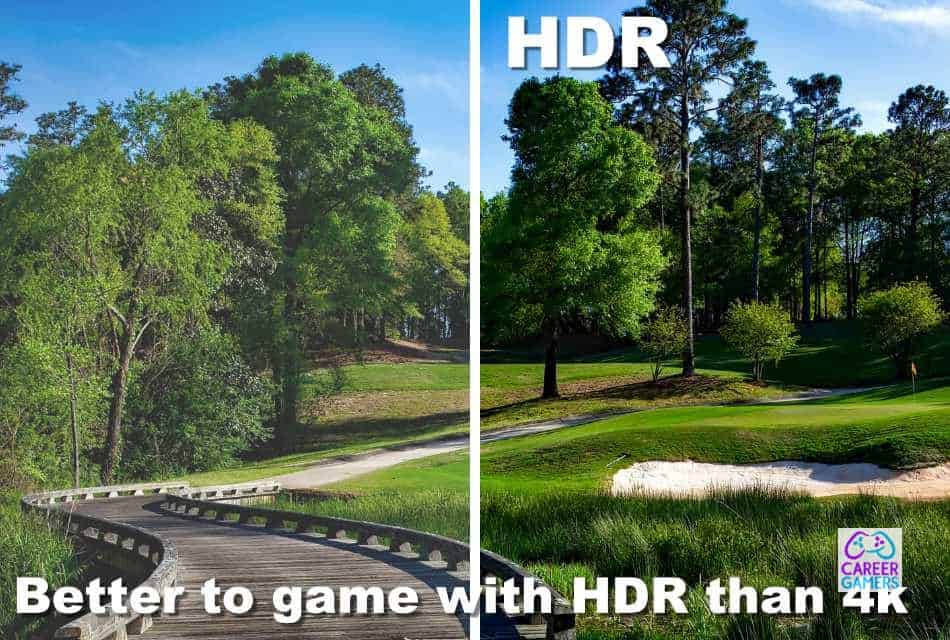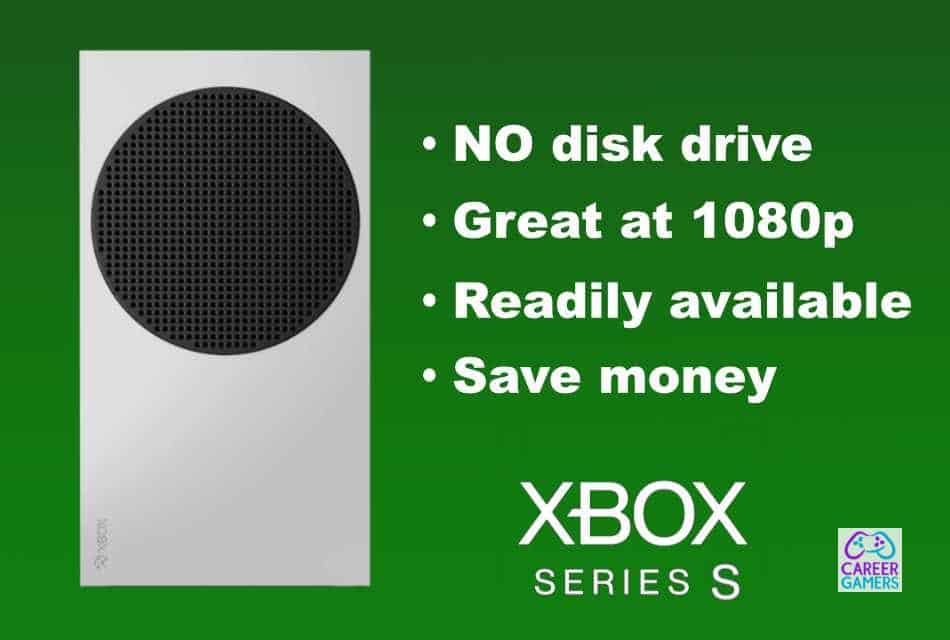A friend of mine, who’s still sporting a curved 1080p LG OLED TV, asked me an interesting question the other day while we were having a round of PGA Tour Golf on the Xbox.
“Nick…”, he said tentatively while swinging his driver on the 8th. “Can the Xbox Series X work on my 1080p OLED TV? I mean, it’s a fantastic TV and all, but I thought the Xbox Series X was built to work with 4K TVs. Will it really be ok on a 1080p TV?”
The question intrigued me as, honestly, I didn’t really know. I hadn’t used either my PS5 or Series X on anything other than my 4k TV.
But I wanted to find out if the Xbox Series X and S were “compatible” with a 1080p TV. After all, my friend couldn’t be the only gamer asking this question. So, I dragged down my little Hitachi 1080p TV from my bedroom and hooked it up to the Xbox Series X.
This is what I found out…
Can the Xbox Series X / S work on a 1080p TV or Monitor? Yes, The Xbox Series X will work perfectly well with a 1080p monitor or TV. In fact, some games may even run soother due to the lower graphical requirements for 1080p compared to 4K. However, some 1080p TVs will be missing modern technologies supported by the new Xbox Series consoles such as variable-rate refresh and 120Hz gaming.
Ok, now you’ve got a quick answer, let’s look at the question in more detail. I’ll also look at which console, X or S, you should buy if gaming on a 1080p TV or monitor.
Will Xbox Series X and S work with a 1080p TV?
Yes, both Xbox Series X and S will work on 1080p TVs and monitors.
The Xbox Series consoles were designed to work with a number of popular TV resolutions from SD 480p all the way up to a future-proofed 8K resolution.
Though gaming at higher resolutions on newer TVs does have its advantages, more at that later, gaming at 1080p also comes with a fair few perks.
Let’s take a look at a few:
60fps@1080p is far better than 30fps at 4K
A resolution of 1080p needs far less GPU power to swing along at 60 frames per second than 4K needs.
A 4k image is made up of 8 million pixels. Each one needs to be computed by the console’s GPU. 1080p, however, is only 2 million pixels. 1/4th the pixels of 4K.
This vast difference in pixel counts means the GPU can deliver more frames per second of a 1080p image than it can of a 4K image.
But why does this matter?
60fps is vastly superior to 30fps. 60 fps gives you a more stable image, decrease controller input latency, makes the image more coherent when the camera is moving, plus a higher frame rates fools the eye into thinking there is more detail than there actually is.
Of course, in a perfect world, we would get 60fps while using a 4k resolution. But the consoles are’t quite there yet.
4k downsampling
One of the advantages of playing on a lower resolution panel is that the Xbox Series X and S will take the higher resolution 4K or 1440p image it natively outputs and downsample it to 1080p
This means that the Xbox essentially takes all those pixels and tries to squeeze them into a smaller space. The information that makes up 4 pixels in 4K is used to make up the information of just 1 high-quality pixel in 1080p.
Generally speaking, a 4K image down sampled onto a 1080p screen looks far crisper than a non-downsampled native 1080p image on a 1080p screen.
So you can expect Xbox Series X and S games to look crisp and detailed on your 1080p TV.
Ok, but what about some of the negatives of using a 1080p TV?
What Xbox Series X / S features am I missing by playing on a 1080p TV/monitor?
Though you will have a wonderful experience playing at 60fps on a 1080p screen, there are other enhancements outside of the resolutions that modern TVs bring to the party.
Many 1080p TVs do not support the following technologies simply because 4K TVs took over before these technologies were used in 1080p TVs.
Some of the features that could be missing on your 1080p Tv or monitor include:
VRR – Variable rate refresh
VRR enables a TV to run at a variable Hz rate that matches the console’s FPS output. Normally, a TV runs at a locked 60Hz and a console has to output frames either at that refresh rate or multiple of it, such as 30 or 20 frames per second, for their game to feel smooth.
Now, with VRR, a game can run at odd frame rates such as 46fps and the TV will match its refresh rate to the game’s FPS. This leads to far smoother gameplay.
Auto Low latency
Auto low latency is when the console communicates with your TV and tells it to switch every picture effect off, like sharpening, in an effort to decrease the latency between controller input and action on screen.
HDR

HDR or High Dynamic Range is just a fancy marketing name for a higher number of colors making up the image on the TV. In the real world, this means you’ll get blacker blacks and whiter whites, which in turn leads to a great number of colors represented on screen.
I personally think that an HDR picture is far, far more important than 4K as the color reproduction is often so astounding the image can look near life-like.
But HDR is often limited to newer TV sets.
120Hz gaming
Probably the biggest reason to buy an updated TV is the fact that older TVs do not support ultra-high frame rates such as 120Hz.
If you’ve read other articles on this site you’ll know that I’m a big believer in high frame rates over high resolutions. I’d rather a slick 60fps @ 1080p and the drudgery of 30fps at 4K.
Fortunately, the new Xbox Series X, and the S to some degree, are capable of sacrificing resolution in an effort to achieve insane frame rates such as 120 fps. And honestly, once you’ve experienced 120fps gaming, it’s nearly impossible to go back.
Is 1080p harmful in any way to the Xbox Series X/S?
Running your Xbox Series X, S, or any other console at 1080p instead of 4K will not harm your console or TV.
The reason is simple: The Xbox is still rendering only the resolutions it is designed to render. You are not forcing it to do anything it was not designed to do.
So you can use your Xbox Series X at 1080p knowing all will be well.
If I’m playing on a 1080p TV should I buy an Xbox Series X or S?
I’d opt to buy the cheaper Xbox Series S.
You’d be getting a great console at an unbelievably low price where you can play thousands of games next-gen games and older Xbox One, 360 and original Xbox games through backward compatbility.
But most importantly, the S will quite happily pump out 1080p@60fps for nearly all games on the console.

Yes, the Xbox Series X is more powerful and will offer higher resolutions. But you don’t need higher resolutions.
If in the future you decide to upgrade your TV you can sell the Xbox Series S and buy either an Xbox Series X or the inevitable mid-generation console update.
I know, a lot of people are obsessed with “future-proofing” but there really isn’t such a thing these days. Technology moves so fast.
Instead, buy what best suits you at the moment. You’ll save money and you might find that you don’t need the more expensive Xbox Series X after all.
Also Xbox Series S consoles are readily available, unlike the Xbox Series X. Take a look here.
Just keep in mind the Xbox Series S doesn’t come with a disk drive, so you’ll need to buy games digitally.

